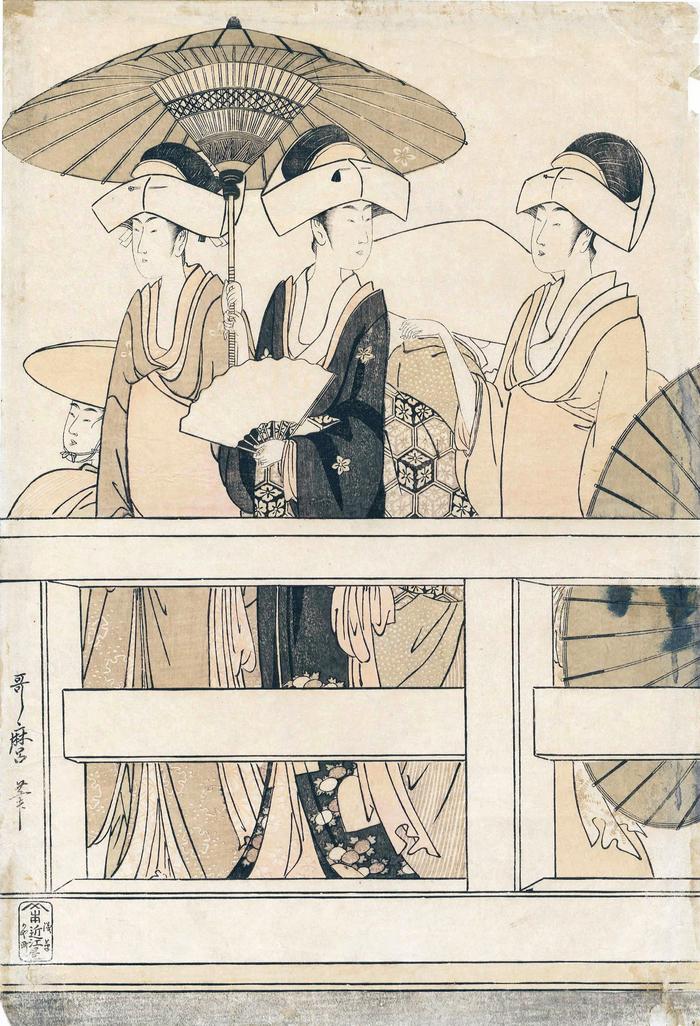Kitagawa Utamaro (喜多川歌麿) (artist ca 1753 – 1806)
Upper left panel of a 6 panel piece: three maids of a samurai mansion - On top of and beneath Ryōgoku Bridge 'Ryōgokubashi no ue, shita' (両国橋上下)
ca 1795 – 1796
10 in x 14.5 in (Overall dimensions) Japanese woodblock print
Signed: Utamaro hitsu (哥麿筆)
Publisher: Ōmiya Gonkurō (Marks 412 - [closest to] seal 23-068)
Metropolitan Museum of Art - the top three panels
Art Institute Chicago - the top three panels
British Museum - the top three panels
Public Domain Museum of Art - the top three panels
Lyon Collection - Goyo copy of all six panels Laurence Binyon wrote in Japanese Colour Prints in 1906 on page 128 about the full composition by Utamaro: "In his unique six-sheet composition of "The Bridge" the figures are tall and slender, but with no wasp-like contractions. There is only one other instance known of a six-sheet composition formed of two triptychs placed, not side by side, but one above the other, and that is a view of a theatre interior, and the audience, by Toyokuni."
****
This image is included in Clark and Asano's catalogue of the great Utamaro exhibition held in London at the British Museum in 1995. The quote below comes from text of that show, pp. 178-9, #254:
"A scene of women enjoying the cool by the Sumida River in summer on top of and beneath Ryōgoku Bridge. The view is facing downstream, past the pillars of the bridge, with the Bukufu boat-houses on the left bank in the background and Shin'ōhashi Bridge in the far distance. To pair triptychs on top and below in this manner is unprecedented, creating an unusually large composition. The figures on top of the bridge look to be a group of three maids from a samurai mansion, wearing head-cloths (age-boshi), and mothers and children. Beneath the bridge covered pleasure-boats (yane-bune) and fast ferries (choki-bune jostle their prows. Common features of Ukiyo-e prints in general demonstrated here are the almost exclusive depiction of women and also the composition of each sheet so as to be worthy of individual appreciation."
****
The center and right panel of the original triptych - of which the print in the Lyon Collection is the left panel - are in the collection of the Museum of Fine Arts in Boston. They also have the entire bottom three prints, in generally good condition, with good color.
****
Illustrated:
1) the top three panels in black and white in Geschichte des japanischen Farbenholzschnitts (A History of Japanese Colour-Prints) by Woldemar von Seidlitz, published by G. Kühtmann, 1910, Abb. 83. From the Vever Collection, Paris.
2) top three panels in color in Japanese Prints : Ukiyo-e in Edo, 1700-1900 by Ellis Tinios, Lund Humphries, 2010, p. 75. Tinois notes of the top three panels: "This triptych forms the top half of a six-sheet composition, which is unprecedented in terms of its size and complexity (the lower triptych shows women in boats beneath the bridge). Utamaro has created an animated frieze of women strolling across the bridge in the cool of the evening. They are subtly differentiated by class, left to right: three maids from a samurai mansion, mothers of the townsman class with their children, and three young women from the pleasure quarters."
3) in color (all 6 panels) in 原色浮世絵大百科事典 (Genshoku Ukiyoe Daihyakka Jiten), vol. 5, pp. 96-97, #379.
****
The top three panels of this composition can be found in the Worcester Art Museum.
beautiful women (bijin-ga - 美人画) (genre)
Ōmiya Gonkurō (近江屋権九郎) (publisher)
Ryōgokubashi (両国橋) (genre)
